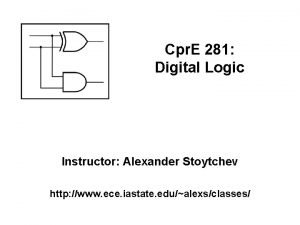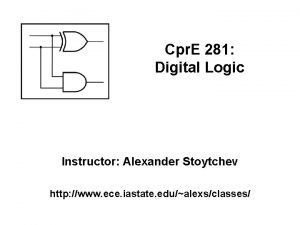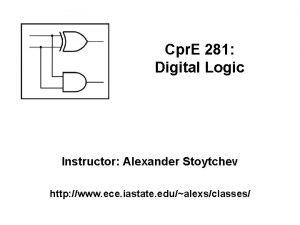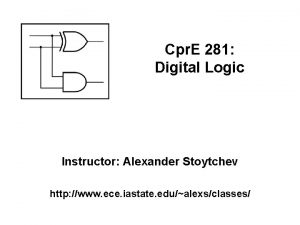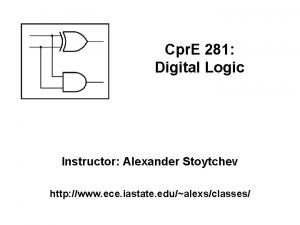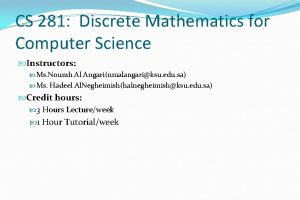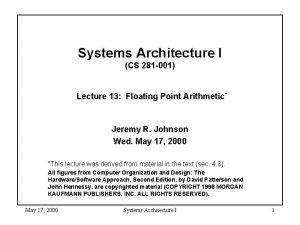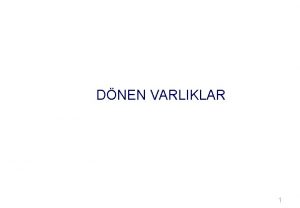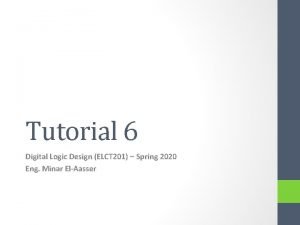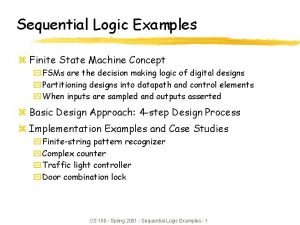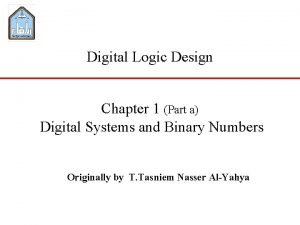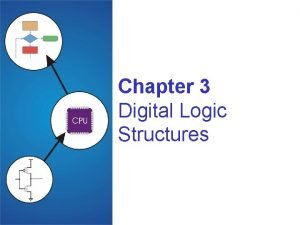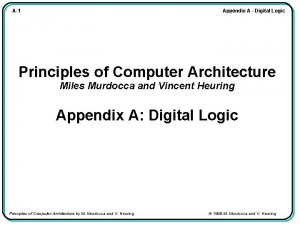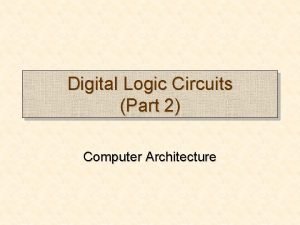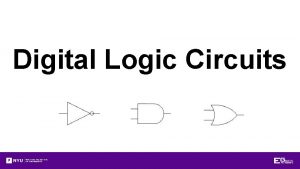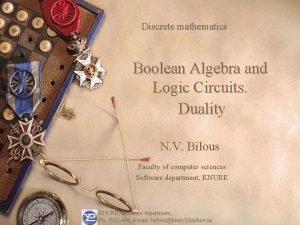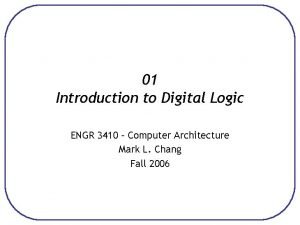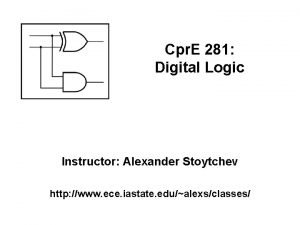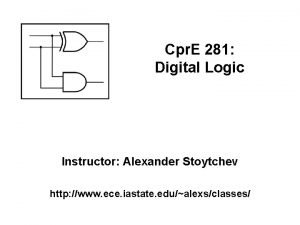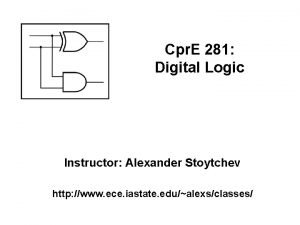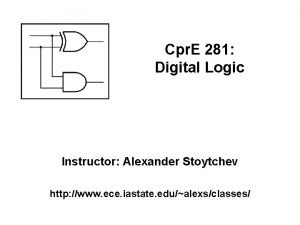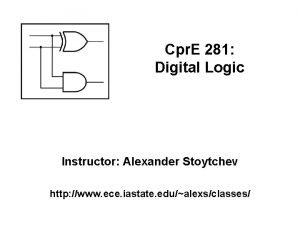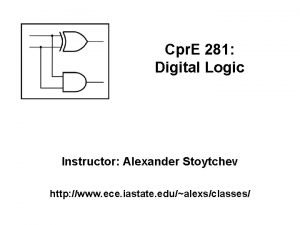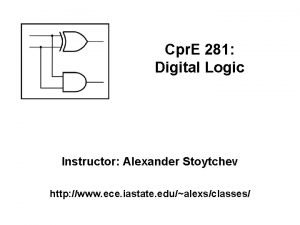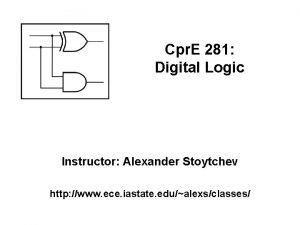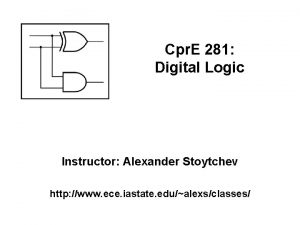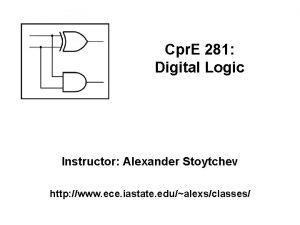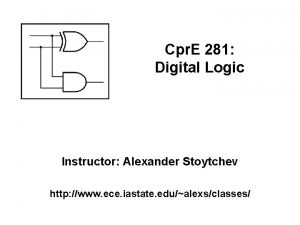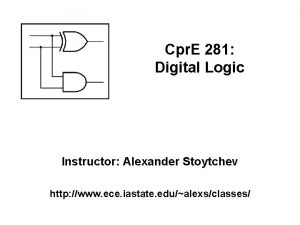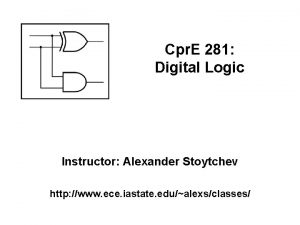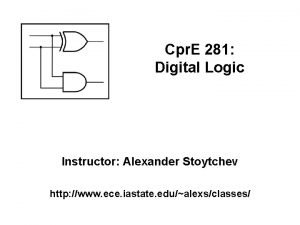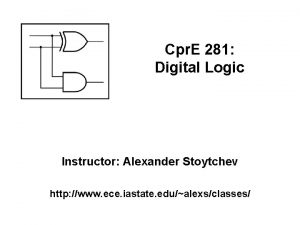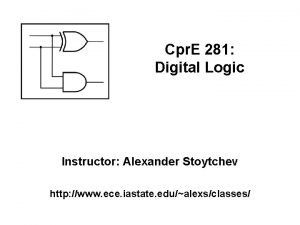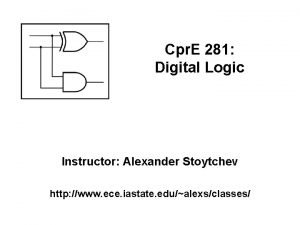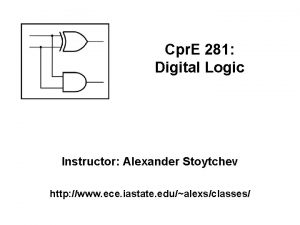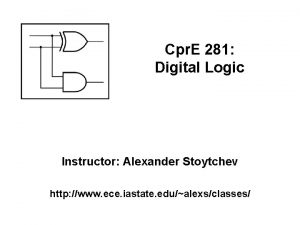Cpr E 281 Digital Logic Instructor Alexander Stoytchev















![Parallel-access shift register [ Figure 5. 18 from the textbook ] Parallel-access shift register [ Figure 5. 18 from the textbook ]](https://slidetodoc.com/presentation_image/5d4a5c0b3005f472033300b0fb668377/image-16.jpg)







![A three-bit up-counter [ Figure 5. 19 from the textbook ] A three-bit up-counter [ Figure 5. 19 from the textbook ]](https://slidetodoc.com/presentation_image/5d4a5c0b3005f472033300b0fb668377/image-24.jpg)





![A three-bit down-counter [ Figure 5. 20 from the textbook ] A three-bit down-counter [ Figure 5. 20 from the textbook ]](https://slidetodoc.com/presentation_image/5d4a5c0b3005f472033300b0fb668377/image-30.jpg)


![A four-bit synchronous up-counter [ Figure 5. 21 from the textbook ] A four-bit synchronous up-counter [ Figure 5. 21 from the textbook ]](https://slidetodoc.com/presentation_image/5d4a5c0b3005f472033300b0fb668377/image-33.jpg)











![A four-bit counter with D flip-flops [ Figure 5. 23 from the textbook ] A four-bit counter with D flip-flops [ Figure 5. 23 from the textbook ]](https://slidetodoc.com/presentation_image/5d4a5c0b3005f472033300b0fb668377/image-45.jpg)

![A counter with parallel-load capability [ Figure 5. 24 from the textbook ] A counter with parallel-load capability [ Figure 5. 24 from the textbook ]](https://slidetodoc.com/presentation_image/5d4a5c0b3005f472033300b0fb668377/image-47.jpg)



![What does this circuit do? [ Figure 5. 25 a from the textbook ] What does this circuit do? [ Figure 5. 25 a from the textbook ]](https://slidetodoc.com/presentation_image/5d4a5c0b3005f472033300b0fb668377/image-51.jpg)





- Slides: 56

Cpr. E 281: Digital Logic Instructor: Alexander Stoytchev http: //www. ece. iastate. edu/~alexs/classes/

Registers & Counters Cpr. E 281: Digital Logic Iowa State University, Ames, IA Copyright © Alexander Stoytchev

Administrative Stuff • The second midterm is next week. • No homework is due next week. • You’ll still have labs though

Administrative Stuff • Midterm Exam #2 • When: Monday March 31. • Where: This classroom • What: Chapters 1, 2, 3, 4 and 5. 1 -5. 7 • The exam will be open book and open notes (you can bring up to 3 pages of handwritten notes).

Midterm 2: Format • The exam will be out of 130 points • You need 95 points to get an A • It will be great if you can score more than 100 points. § but you can’t roll over your extra points

Midterm 2: Topics • • Binary Numbers and Hexadecimal Numbers 1’s complement and 2’s complement representation Addition and subtraction of binary numbers Circuits for adders and fast adders • Single and Double precision IEEE floating point formats • Converting a real number to the IEEE format • Converting a floating point number to base 10 • Multiplexers (circuits and function) • Synthesis of logic functions using multiplexers • Shannon’s Expansion Theorem

Midterm 2: Topics • • • Decoders (circuits and function) Demultiplexers Encoders (binary and priority) Code Converters K-maps for 2, 3, and 4 variables • Synthesis of logic circuits using adders, multiplexers, encoders, decoders, and basic logic gates • Synthesis of logic circuits given constraints on the available building blocks that you can use • Latches (circuits, behavior, timing diagrams) • Flip-Flops (circuits, behavior, timing diagrams)

Registers

Register (Definition) An n-bit structure consisting of flip-flops

Parallel-Access Register

1 -bit Parallel-access register IN LD Clock 1 0 D Q Q • At the input of the D flip-flop, a 2 -to-1 Multiplexer is used to select whether to load a new input value or to retain the old value • If signal LD = 1 then load the new value • If signal LD = 0 then retain the old value

4 -bit Parallel-access register LD IN 3 IN 2 1 0 D Q Q 3 IN 0 1 0 D Q Clock IN 1 Q D Q Q 2 Q Q Q 1 Notice that all flip-flops are on the same clock cycle. Q 0

Shift Register

A simple shift register In Clock D Q Q 1 D Q Q Q 2 D Q Q Q 3 Q D Q Q 4 Out Q (a) Circuit In Q 1 Q 2 Q 3 Q 4 = Out t 0 1 0 0 t 1 0 0 0 t 2 1 0 0 t 3 1 1 0 t 4 1 1 1 0 1 t 5 0 1 1 1 0 t 6 0 0 1 1 1 t 7 0 0 0 1 1 (b) A sample sequence [ Figure 5. 17 from the textbook ]

Parallel-Access Shift Register
![Parallelaccess shift register Figure 5 18 from the textbook Parallel-access shift register [ Figure 5. 18 from the textbook ]](https://slidetodoc.com/presentation_image/5d4a5c0b3005f472033300b0fb668377/image-16.jpg)
Parallel-access shift register [ Figure 5. 18 from the textbook ]

Register File

Register File • Register file is a unit containing r registers RA 1 RA 2 § r can be 4, 8, 16, 32, etc. • Each register has n bits § n can be 4, 8, 16, 32, etc. § n defines the data path width DATA 1 LD_DATA • Output ports (DATA 1 and DATA 2) are used for reading the register file § Any register can be read from any of the ports § Each port needs a log 2 r bits to specify the read address (RA 1 and RA 2) • Input port (LD_DATA) is used for writing data to the register file § Write address is also specified by log 2 r bits (WA) § Writing is enabled by a 1 -bit signal (WR) Reg File DATA 2 WR WA

Register File: Exercise • Suppose that a register file § contains 32 registers § width of data path is 16 bits (i. e. , each register has 16 bits) RA 1 DATA 1 LD_DATA • How many bits are there for each of the signals? § § § § RA 1 RA 2 DATA 1 DATA 2 WA LD_DATA WR 5 5 16 16 5 16 1 RA 2 Reg File DATA 2 WR WA

Register file design • We will design an eight-register file with 4 -bit wide registers • A single 4 -bit register and its abstraction are shown below LD D 3 D 2 D 1 D 0 LD 1 0 D Q P Q 3 1 0 D Q P Q 2 1 0 D Q P Q 1 1 0 D Q P Q 0 D 3 D 2 D 1 D 0 Q 3 Q 2 Q 1 Q 0 Clock • We have to use eight such registers to make an eight register file LD D 3 D 2 D 1 D 0 LD Q 3 Q 2 Q 1 Q 0 Clk D 3 D 2 D 1 D 0 Q 3 Q 2 Q 1 Q 0 Clk • How many bits are required to specify a register address?

Reading Circuit • A 3 -bit register address, RA, specifies which register is to be read • For each output port, we need one 8 -to-1 4 -bit multiplier Register Address 111 000 LD 7 D 3 D 2 D 1 D 0 LD 1 D 3 D 2 D 1 D 0 LD 0 D 3 D 2 D 1 D 0 Q 3 Q 2 Q 1 Q 0 Clk 7 6 5 4 3 2 1 0 RA 1 8 -to-1 4 -bit multiplex DATA 1 Clk 7 6 5 4 3 2 1 0 8 -to-1 4 -bit multiplex RA 2 DATA 2

Adding write control to register file • To write to any register, we need the register's address (WA) and a write register signal (WR) • A 3 -bit write address is decoded if write register signal is present • One of the eight registers gets a LD signal from the decoder LD_DATA WA 3 to 8 D e c o d e r LD 7 D 3 D 2 D 1 D 0 LD 1 D 3 D 2 D 1 D 0 LD 0 D 3 D 2 D 1 D 0 Q 3 Q 2 Q 1 Q 0 111 001 Clk LD 2 LD 1 LD 0 Clk 7 6 5 4 3 2 1 0 RA 1 8 -to-1 4 -bit multiplex 000 Clk 7 6 5 4 3 2 1 0 8 -to-1 4 -bit multiplex RA 2 WR DATA 1 DATA 2

Counters
![A threebit upcounter Figure 5 19 from the textbook A three-bit up-counter [ Figure 5. 19 from the textbook ]](https://slidetodoc.com/presentation_image/5d4a5c0b3005f472033300b0fb668377/image-24.jpg)
A three-bit up-counter [ Figure 5. 19 from the textbook ]

A three-bit up-counter The first flip-flop changes on the positive edge of the clock [ Figure 5. 19 from the textbook ]

A three-bit up-counter The first flip-flop changes on the positive edge of the clock The second flip-flop changes on the positive edge of Q 0 [ Figure 5. 19 from the textbook ]

A three-bit up-counter The first flip-flop changes on the positive edge of the clock The second flip-flop changes The third flip-flop changes on the positive edge of Q 0 on the positive edge of Q 1 [ Figure 5. 19 from the textbook ]

A three-bit up-counter 1 T Clock Q T Q Q 0 Q Q Q 1 Q 2 (a) Circuit Clock Q 0 Q 1 Q 2 Count 0 1 2 3 4 5 6 7 0 (b) Timing diagram [ Figure 5. 19 from the textbook ]

A three-bit up-counter 1 T Clock Q T Q Q 0 Q Q 1 (a) Circuit Q Q 2 The propagation delays get longer Clock Q 0 Q 1 Q 2 Count 0 1 2 3 4 5 6 7 0 (b) Timing diagram [ Figure 5. 19 from the textbook ]
![A threebit downcounter Figure 5 20 from the textbook A three-bit down-counter [ Figure 5. 20 from the textbook ]](https://slidetodoc.com/presentation_image/5d4a5c0b3005f472033300b0fb668377/image-30.jpg)
A three-bit down-counter [ Figure 5. 20 from the textbook ]

A three-bit down-counter 1 T Clock Q T Q Q 0 Q Q Q 1 Q 2 (a) Circuit Clock Q 0 Q 1 Q 2 Count 0 7 6 5 4 3 (b) Timing diagram 2 1 0 [ Figure 5. 20 from the textbook ]

Synchronous Counters
![A fourbit synchronous upcounter Figure 5 21 from the textbook A four-bit synchronous up-counter [ Figure 5. 21 from the textbook ]](https://slidetodoc.com/presentation_image/5d4a5c0b3005f472033300b0fb668377/image-33.jpg)
A four-bit synchronous up-counter [ Figure 5. 21 from the textbook ]

A four-bit synchronous up-counter The propagation delay through all AND gates combined must not exceed the clock period minus the setup time for the flip-flops [ Figure 5. 21 from the textbook ]

A four-bit synchronous up-counter 1 T Clock Q Q 0 T Q Q Q T Q 1 Q Q 2 T Q Q Q 3 Q (a) Circuit Clock Q 0 Q 1 Q 2 Q 3 Count 0 1 2 3 4 5 6 7 8 9 10 11 12 13 (b) Timing diagram 14 15 0 1 [ Figure 5. 21 from the textbook ]

Derivation of the synchronous up-counter Clock cycle 0 1 2 3 4 5 6 7 8 Q 2 Q 1 Q 0 0 0 1 1 0 0 1 0 1 0 Q 1 changes Q 2 changes [ Table 5. 1 from the textbook ]

Derivation of the synchronous up-counter Clock cycle 0 1 2 3 4 5 6 7 8 Q 2 Q 1 Q 0 0 0 1 1 0 0 1 0 1 0 Q 1 changes Q 2 changes T 0= 1 T 1 = Q 0 T 2 = Q 0 Q 1 [ Table 5. 1 from the textbook ]

A four-bit synchronous up-counter T 0= 1 T 1 = Q 0 T 2 = Q 0 Q 1 [ Figure 5. 21 from the textbook ]

In general we have T 0= 1 T 1 = Q 0 T 2 = Q 0 Q 1 T 3 = Q 0 Q 1 Q 2 … Tn = Q 0 Q 1 Q 2 …Qn-1

Adding Enable and Clear Capability

Inclusion of Enable and Clear capability Enable Clock T Q Q Clear_n [ Figure 5. 22 from the textbook ]

Inclusion of Enable and Clear capability This is the new thing relative to the previous figure, plus the clear_n line Enable Clock T Q Q Clear_n [ Figure 5. 22 from the textbook ]

Providing an enable input for a D flip-flop [ Figure 5. 56 from the textbook ]

Synchronous Counter with D Flip-Flops
![A fourbit counter with D flipflops Figure 5 23 from the textbook A four-bit counter with D flip-flops [ Figure 5. 23 from the textbook ]](https://slidetodoc.com/presentation_image/5d4a5c0b3005f472033300b0fb668377/image-45.jpg)
A four-bit counter with D flip-flops [ Figure 5. 23 from the textbook ]

Counters with Parallel Load
![A counter with parallelload capability Figure 5 24 from the textbook A counter with parallel-load capability [ Figure 5. 24 from the textbook ]](https://slidetodoc.com/presentation_image/5d4a5c0b3005f472033300b0fb668377/image-47.jpg)
A counter with parallel-load capability [ Figure 5. 24 from the textbook ]

A shift register with parallel load and enable control inputs [ Figure 5. 59 from the textbook ]

Reset Synchronization

Motivation • An n-bit counter counts from 0, 1, …, 2 n-1 • For example a 3 -bit counter counts up as follow § 0, 1, 2, 3, 4, 5, 6, 7, 0, 1, 2, … • What if we want it to count like this § 0, 1, 2, 3, 4, 5, 0, 1, … • In other words, what is the cycle is not a power of 2?
![What does this circuit do Figure 5 25 a from the textbook What does this circuit do? [ Figure 5. 25 a from the textbook ]](https://slidetodoc.com/presentation_image/5d4a5c0b3005f472033300b0fb668377/image-51.jpg)
What does this circuit do? [ Figure 5. 25 a from the textbook ]

A modulo-6 counter with synchronous reset 1 Enable 0 D 0 Q 0 0 D 1 Q 1 0 D 2 Q 2 Load Clock (a) Circuit Clock Q 0 Q 1 Q 2 Count 0 1 2 3 4 (b) Timing diagram 5 0 1 [ Figure 5. 25 from the textbook ]

A modulo-6 counter with asynchronous reset 1 T Clock Q Q 0 Q T Q 1 Q Q 2 Q (a) Circuit Clock Q 0 Q 1 Q 2 Count 0 1 2 3 4 (b) Timing diagram 5 0 1 2 [ Figure 5. 26 from the textbook ]

A modulo-6 counter with asynchronous reset 1 T Clock Q Q 0 Q T Q 1 Q Q 2 Q The number 5 is displayed for a very short amount of time (a) Circuit Clock Q 0 Q 1 Q 2 Count 0 1 2 3 4 (b) Timing diagram 5 0 1 2 [ Figure 5. 26 from the textbook ]

Questions?

THE END
 Stoytchev 281
Stoytchev 281 Stoytchev 281
Stoytchev 281 Cpr e 281
Cpr e 281 Alexander stoytchev
Alexander stoytchev Stoytchev
Stoytchev Ipx 281
Ipx 281 Cs281 wordpress
Cs281 wordpress Geo 281
Geo 281 Formation of soil
Formation of soil 2812840027
2812840027 Cs 281
Cs 281 Nmeros romanos
Nmeros romanos Dönem ayırıcı hesaplar örnek
Dönem ayırıcı hesaplar örnek Dönem ayirici hesaplar 180 181 280 281 380 381
Dönem ayirici hesaplar 180 181 280 281 380 381 First order logic vs propositional logic
First order logic vs propositional logic First order logic vs propositional logic
First order logic vs propositional logic First order logic vs propositional logic
First order logic vs propositional logic Concurrent vs sequential
Concurrent vs sequential Tw
Tw 캠블리 단점
캠블리 단점 Majority circuit
Majority circuit Combinational logic sequential logic 차이
Combinational logic sequential logic 차이 Logic chapter 3
Logic chapter 3 Digital logic design tutorial
Digital logic design tutorial Fsm digital logic
Fsm digital logic Logic gate timing diagram
Logic gate timing diagram Digital system design
Digital system design Digital logic controller
Digital logic controller Canonical form digital logic
Canonical form digital logic Digital logic design practice problems
Digital logic design practice problems Logic gates identities
Logic gates identities Digital logic design lectures
Digital logic design lectures Digital logic structures
Digital logic structures Consensus theorem in digital electronics
Consensus theorem in digital electronics Bubble matching digital logic
Bubble matching digital logic Digital logic and computer architecture
Digital logic and computer architecture Uncommon logic digital
Uncommon logic digital Bubble matching digital logic
Bubble matching digital logic Law of duality in discrete mathematics
Law of duality in discrete mathematics Digital logic design
Digital logic design Bubble matching digital logic
Bubble matching digital logic Participante contreras
Participante contreras Tcole instructor course
Tcole instructor course Basic instructor course texas
Basic instructor course texas Basic instructor course texas
Basic instructor course texas Pepperball training manual
Pepperball training manual Everyone selected to serve on this jury
Everyone selected to serve on this jury Instructor vs teacher
Instructor vs teacher Cisco certified instructor
Cisco certified instructor Mptc firearms instructor manual
Mptc firearms instructor manual Basic instructor course #1014
Basic instructor course #1014 Basic instructor course #1014
Basic instructor course #1014 The virtual instructor
The virtual instructor Nfpa 1403 instructor to student ratio
Nfpa 1403 instructor to student ratio Human factors instructor
Human factors instructor Instructor operating station
Instructor operating station Catia instructor
Catia instructor
